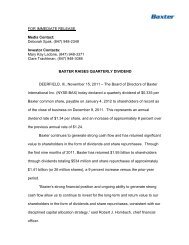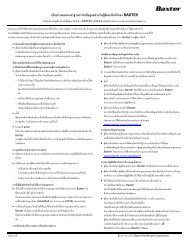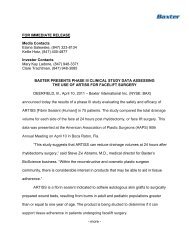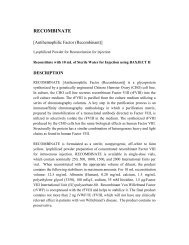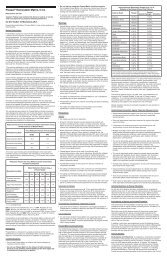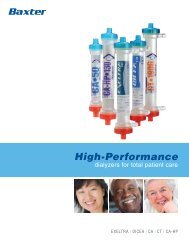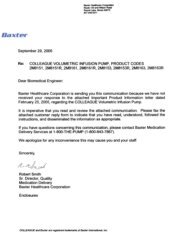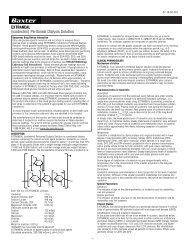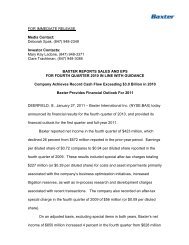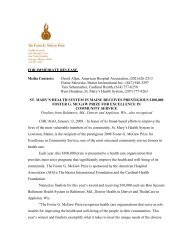FLOSEAL 10mL IFU - Baxter
FLOSEAL 10mL IFU - Baxter
FLOSEAL 10mL IFU - Baxter
Create successful ePaper yourself
Turn your PDF publications into a flip-book with our unique Google optimized e-Paper software.
Floseal ® Hemostatic Matrix, 10 mL<br />
Instructions for Use:<br />
Caution: Federal Law restricts this device to sale by or on the order of<br />
a physician (or properly licensed practitioner).<br />
DO NOT INJECT INTRAVASCULARLY.<br />
Floseal Hemostatic Matrix (“Floseal Matrix”) must not be injected into<br />
blood vessels.<br />
Device Description:<br />
Floseal Matrix consists of a bovine-derived Gelatin Matrix component,<br />
a human-derived Thrombin component, applicator tips, and several<br />
mixing accessories. The mixing accessories include a syringe, a Luer<br />
connector, a small bowl, and a 5 mL syringe with needle attached. The<br />
mixing accessories are included to facilitate the reconstitution and<br />
mixing of the Thrombin into the Gelatin Matrix. Applicator tips are<br />
included to facilitate the delivery of Floseal Matrix to the site to be treated.<br />
(For specific package contents, see table in “How Supplied” section.)<br />
The Gelatin Matrix consists of cross-linked gelatin granules and is<br />
provided sterile and non-pyrogenic in a standard disposable syringe.<br />
The Thrombin (Human) is a sterile, non-pyrogenic, freeze-dried,<br />
vapor-heated and solvent/detergent treated powder preparation made<br />
from pooled human plasma. The Calcium Chloride Solution is a sterile,<br />
non-pyrogenic solution. After reconstitution of the lyophilized Thrombin<br />
in Calcium Chloride Solution, the resulting Thrombin solution contains<br />
500 units*/mL Thrombin (Human).<br />
*The potency expressed in units is determined using a clotting assay<br />
against an internal reference standard for potency that has been<br />
calibrated against the World Health Organization (WHO) Second<br />
International Standard for Thrombin, 01/580. Therefore, a unit used<br />
herein is equivalent to an International Unit.<br />
Source Plasma, obtained from US licensed plasma collection centers, is<br />
used to produce FEIBA bulk powder, the starting material of Thrombin.<br />
(Final product, FEIBA VH Anti-Inhibitor Coagulant Complex, which is<br />
manufactured by <strong>Baxter</strong> Healthcare Corporation from the same bulk,<br />
is licensed and distributed in the US and Canada for the control of<br />
spontaneous bleeding episodes or to cover surgical interventions in<br />
hemophilia A and B patients with inhibitors.) Thrombin is prepared by<br />
dissolving FEIBA bulk powder and incubating the solution with Calcium<br />
Chloride in order to activate prothrombin to Thrombin. After several<br />
filtration steps, the final bulk solution is freeze-dried. The Calcium<br />
Chloride Solution is prepared from Calcium Chloride complying with the<br />
specifications listed in the US Pharmacopeia.<br />
Thrombin is made from pooled human plasma. The two-step vapor<br />
heat and solvent/detergent treatment used in its manufacture has<br />
been shown to be capable of significant viral reduction. However, no<br />
procedure has been shown to be completely effective in removing viral<br />
infectivity from derivatives of human plasma (see “Warnings”).<br />
The manufacturing procedure for Floseal Matrix includes processing<br />
steps designed to reduce the risk of viral transmission. Several steps<br />
are included in the manufacture of the Gelatin Matrix component that<br />
reduce the risk of viral transmission. The virus reduction factors<br />
(expressed as log 10) for the manufacture of the Gelatin Matrix component<br />
are provided in the table below.<br />
Reduction Factors for Virus Removal and/or Inactivation<br />
During the Manufacture of Gelatin Matrix<br />
A two-step vapor heating and solvent/detergent treatment process is<br />
included in the manufacture of Thrombin. The virus reduction factors<br />
(expressed as log 10) for Thrombin are provided in the table below.<br />
Reduction Factors for Virus Removal and/or Inactivation<br />
During the Manufacture of Thrombin (Human)<br />
Manufacturing<br />
Step<br />
Thrombin precursor<br />
mass capture<br />
Vapor Heat<br />
Treatment<br />
Solvent/Detergent<br />
Treatment<br />
Ion Exchange<br />
Chromatography<br />
Overall Reduction<br />
Factor (ORF)<br />
n. d. = not determined<br />
HIV-1: Human immunodeficiency virus 1; HAV: Hepatitus A virus;<br />
BVDV: Bovine viral diarrhea virus, a model for Hepatitus C virus; PRV:<br />
Pseudorabies virus, a model for enveloped DNA viruses, among<br />
those Hepatitus B virus; MMV: Mice minute virus, a model for Human<br />
Parvovirus B19; B19V: Human Parvovirus B19.<br />
Floseal Matrix is the combination of the Gelatin Matrix component<br />
and the reconstituted Thrombin (Human) component. Thrombin must<br />
be added to the Gelatin Matrix component prior to use. Floseal Matrix<br />
is biocompatible and resorbed within 6 to 8 weeks, consistent with<br />
normal wound healing. Floseal Matrix is intended only for topical<br />
administration.<br />
Indications:<br />
Floseal Matrix is indicated in surgical procedures (other than in<br />
ophthalmic) as an adjunct to hemostasis when control of bleeding by<br />
ligature or conventional procedures is ineffective or impractical.<br />
Contraindications:<br />
Virus Reduction<br />
Factor of Virus Tested<br />
Manufacturing Step BVDV PPV<br />
Base Treatment (NaOH) >5.4 4.0<br />
Chemical Cross-linking >5.0 1.1<br />
Heat Treatment >6.5 1.9<br />
Virus Reduction Factor of Virus Tested<br />
HIV-1 HAV BVDV PRV MMV B19V<br />
3.2 1.5 1.8 2.5 1.2 1.7<br />
>5.5 >4.9 >5.3 >6.7 1.0 >4<br />
>5.3 n.d. >5.5 >6.4 n.d. n.d.<br />
n.d. n.d. n.d. n.d. 3.6 n.d.<br />
>14.0 >6.4 >12.6 >15.6 5.8 >5.7<br />
• Do not use Floseal Matrix in patients with known allergies to<br />
materials of bovine origin.<br />
• Do not use Floseal Matrix in the closure of skin incisions<br />
because it may interfere with the healing of the skin edges due<br />
to mechanical interposition of gelatin.<br />
• Do not inject or compress Floseal Matrix into blood vessels.<br />
Do not apply Floseal Matrix in the absence of active blood flow, eg.,<br />
while the vessel is clamped or bypassed. Extensive intravascular<br />
clotting and even death may result.<br />
• To avoid a risk of allergic-anaphylactoid reaction and/or<br />
thromboembolic events, which may be life threatening, do not inject<br />
Floseal Matrix into a vessel or tissue.<br />
Warnings:<br />
• Floseal Matrix contains Thrombin made from human plasma.<br />
Products made from human plasma may contain infectious agents,<br />
such as viruses, that can cause disease. The risk that such<br />
products will transmit an infectious agent has been reduced by<br />
screening plasma donors for prior exposure to certain viruses, by<br />
testing for the presence of certain current virus infections, and by<br />
inactivating and removing certain viruses. Despite these measures,<br />
such products can still potentially transmit disease. Because this<br />
product is made from human blood, it may carry a risk of<br />
transmitting infectious agents, e.g., viruses, and theoretically, the<br />
Creutzfeldt-Jakob disease (CJD) agent. ALL infections thought by a<br />
physician possibly to have been transmitted by this product should<br />
be reported by the physician or other healthcare provider to <strong>Baxter</strong><br />
Healthcare Corporation. The physician should discuss the risks and<br />
benefits of this product with the patient.<br />
• Floseal Matrix is not intended as a substitute for meticulous surgical<br />
technique and the proper application of ligatures or other<br />
conventional procedures for hemostasis. Floseal Matrix is effective<br />
on surgical bleeding, from oozing to spurting, and is not intended to<br />
be used as a prophylactic hemostatic agent.<br />
• Excess Floseal Matrix (material not incorporated in the hemostatic<br />
clot) should always be removed by gentle irrigation from the site of<br />
application. Meticulous irrigation is required when used in, around,<br />
or in proximity to foramina in bone, areas of bony confine, the spinal<br />
cord, the brain and/or cranial nerves.<br />
• Floseal Matrix should not be used in the presence of infection.<br />
Floseal Matrix should be used with caution in contaminated areas<br />
of the body. If signs of infection or abscess develop where Floseal<br />
Matrix has been applied, reoperation may be necessary in order to<br />
remove the infected material and allow drainage.<br />
• Regardless of the type of surgical procedure, surgeons should<br />
consider the maximum swell volume of approximately 20% of<br />
Floseal Matrix after product is applied and its potential effect on the<br />
surrounding anatomic areas. Maximum swell volume is achieved<br />
within about 10 minutes.<br />
• The safety and effectiveness of Floseal Matrix for use in ophthalmic<br />
procedures has not been established.<br />
• Floseal Matrix should not be used for controlling post-partum<br />
bleeding or menorrhagia.<br />
• The safety and effectiveness of Floseal Matrix has not been<br />
established in children and pregnant women.<br />
Precautions:<br />
General<br />
• For single use only. Do not resterilize.<br />
• Since the Thrombin Solution can be denatured by contact with<br />
solutions containing alcohol, iodine, or heavy metal ions, Floseal<br />
Matrix should not be applied before the application site is cleaned<br />
to remove any antiseptics that may contain such substances.<br />
• When placed into cavities or closed tissue spaces, gentle<br />
approximation is advised. When applied to a bleeding site, the<br />
particles of Floseal Matrix swell approximately 20% upon contact<br />
with blood or other fluids. Maximum swell volume is achieved within<br />
about 10 minutes.<br />
• As with other hemostatic agents, do not aspirate Floseal Matrix into<br />
extra corporeal cardiopulmonary bypass circuits or autologous<br />
blood salvage circuits. It has been demonstrated that fragments<br />
of collagen based hemostatic agents may pass through 40μm<br />
transfusion filters of blood scavenging systems.<br />
• Floseal Matrix should not be used in conjunction with<br />
methylmethacrylate or other acrylic adhesives. Microfibrillar<br />
collagen has been reported to reduce the strength of<br />
methylmethacrylate adhesives used to attach prosthetic devices<br />
to bone surfaces. Do not use Floseal on bone surfaces where<br />
adhesives will be required to attach a prosthetic device.<br />
• Floseal Matrix should not be used for the primary treatment of<br />
coagulation disorders.<br />
• The safety and effectiveness of the combined use of Floseal Matrix<br />
with antibiotic solutions or powders has not been established.<br />
• The safety and effectiveness for use in neurosurgical and urological<br />
procedures has not been established through randomized clinical<br />
studies.<br />
• In urological procedures, Floseal Matrix should not be left in the<br />
renal pelvis or ureters to eliminate the potential foci for calculus<br />
formation.<br />
Information for Patients<br />
• Some viruses, such as parvovirus B 19, are particularly difficult to<br />
remove or inactivate at this time. Parvovirus B 19 most seriously<br />
affects pregnant women, or immune-compromised individuals.<br />
Symptoms of parvovirus B 19 infection include fever, drowsiness,<br />
chills, and runny nose followed about two weeks later by a rash and<br />
joint pain. Patients should be encouraged to consult their physician<br />
if such symptoms appear.<br />
Carcinogenesis, Mutagenesis, Impairment of Fertility<br />
• Long-term animal studies to evaluate the carcinogenic potential of<br />
Floseal Matrix or studies to determine the effect of Floseal Matrix<br />
on fertility have not been performed.<br />
Use in Pregnancy<br />
• It is not known whether Floseal Matrix can cause fetal harm when<br />
administered to a pregnant woman or can affect reproduction<br />
capacity. Floseal Matrix should be administered to a pregnant<br />
woman only if clearly needed.<br />
Floseal Matrix Adverse Events:<br />
In a randomized prospective, concurrently controlled clinical trial using<br />
a formulation of Floseal Matrix containing bovine Thrombin, (Floseal),<br />
a total of 309 patients received Floseal or the Control (Gelatin Sponge<br />
+ Thrombin). The most common adverse events recorded during and<br />
after the application of the hemostatic agents were anemia, atrial<br />
fibrillation, infection, and hemorrhage. The following is a complete<br />
list of adverse events reported in greater than 1% of patients that<br />
were observed in the pivotal clinical trial for the Floseal group. The<br />
corresponding adverse events for the Control group are listed for<br />
comparison. None of the adverse events that occurred were judged by<br />
the surgeon to be “Probably Related” to the use of Floseal.<br />
Adverse Events Reported in Greater than 1% of Patients in the<br />
Floseal Clinical Trial Patients<br />
Adverse Event Floseal Control<br />
(Gelatin Sponge + Thrombin)<br />
Anemia 12 (8%) 7 (4%)<br />
Fibrillation Atrial 10 (6%) 8 (5%)<br />
Infection 10 (6%) 11 (7%)<br />
Hemorrhage 6 (4%) 6 (4%)<br />
Pneumonia 6 (4%) 2 (1%)<br />
Urinary Tract Infection 6 (4%) 3 (2%)<br />
Rash 5 (3%) 3 (2%)<br />
Edema 5 (3%) 1 (
Patients were randomized only after it was determined that the bleeding<br />
could not be controlled using conventional approaches (e.g. direct<br />
pressure, sutures and/or cautery) because of their ineffectiveness or<br />
impracticality. Success at achieving hemostasis was defined as<br />
cessation of bleeding within 10 minutes following application of the<br />
agent. The primary endpoint was hemostasis success for the first<br />
treated bleeding site. A secondary endpoint was time to hemostasis<br />
for the first treated bleeding site. Although multiple bleeding sites in<br />
the same patient were treated, only the first treated bleeding site was<br />
used to determine primary effectiveness, as this was the only site that<br />
was truly randomized.<br />
Clinical Study Results:<br />
Primary Endpoint: The primary endpoint, cessation of bleeding within<br />
10 minutes of the first lesion, achieved a success rate of 96% in the<br />
Floseal group and 77% in the Control group. Treatment and Control<br />
were shown to be equivalent using the Blackwelder and Chang test,<br />
using a � (clinically significant difference) of 0.15 (p



